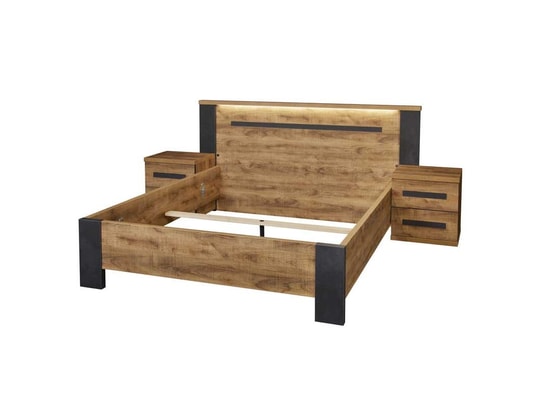
Cadre + Tête de lit 180*200 + Chevets Chêne/Noir FIP - Univers de la Chambre Dimensions lit 180 x 200 cm Couleur Bois clair Matière Bois Dimensions 180 x 200 cm

TRU Cadre de Lit pour Matelas 180 x 200 cm, Lit Double en Bois d'ingénierie, avec Sommier Tissu, 203 x 183 x 50 cm Noir TR428 - Cdiscount Maison

Structure de Lit 180 x 200 cm - Cadre de Lit pour Adulte, Bois de pin massif 283165 QI044 - Cdiscount Maison

Cadre de lit plateforme en métal 46 cm Joseph ZINUS | Sommier | Support à lattes en bois | Rangement sous le lit | 180 x 200 cm | Noir : Amazon.fr: Cuisine et Maison
![Cadre de lit en métal robuste sommier à lattes solide lit double acier laqué 180 x 200 cm noir mat [en.casa] - Conforama Cadre de lit en métal robuste sommier à lattes solide lit double acier laqué 180 x 200 cm noir mat [en.casa] - Conforama](https://cdn.conforama.fr/prod/product/image/fbbc/G_CNF_Y32712920_B.jpeg)
Cadre de lit en métal robuste sommier à lattes solide lit double acier laqué 180 x 200 cm noir mat [en.casa] - Conforama

Hêtre Lit en bois Cadre de lit 180 x 200 cm Blanc, Höhe (cm) 97,50, Länge/Tiefe (cm) 208, Breite (cm) 186, Matratzenmaße (B x L cm) 180 x 200, Massivholz Oui, Material

Cadre de lit 180*200 cm avec chevets Chêne + LEDs LOPEL Dimensions lit 180 x 200 cm Couleur Bois clair Matière Bois Dimensions 180 x 200 cm

Hêtre Bois massif Cadre de lit 180 x 200 cm Blanc, Höhe (cm) 98, Länge/Tiefe (cm) 208, Breite (cm) 186, Matratzenmaße (B x L cm) 180 x 200, Massivholz Oui, Material Bois

Lit Adulte,Sommier tapissier, Cadre de Lit,Lit double - Gris Tissu 180 x 200 cm DETHB23756 MaisonChic

Cadre de lit 180 x 200 cm 1,8 m Super King - Matériau du cadre de lit : pin massif (non traité - Matériau des lattes : contreplaqué : Amazon.fr: Cuisine et Maison



![Cadre de lit double Kreta en Métal 180 x 200 cm Noir [en.casa] | Leroy Merlin Cadre de lit double Kreta en Métal 180 x 200 cm Noir [en.casa] | Leroy Merlin](https://media.adeo.com/marketplace/MKP/84846356/d5ea4ca94ab0c3a273a1e960c639b0d9.jpeg?width=650&height=650&format=jpg&quality=80&fit=bounds)











![Cadre de lit double Florenz Acier Revêtu par Poudre 180 x 200 Noir [en.casa] | premiumXL Cadre de lit double Florenz Acier Revêtu par Poudre 180 x 200 Noir [en.casa] | premiumXL](https://www.premiumxl.fr/media/catalog/product/cache/7de1c9b53285db9477a24fc094984be3/1/4/14a2efd760b930655a294e20a66ab38a.jpg)